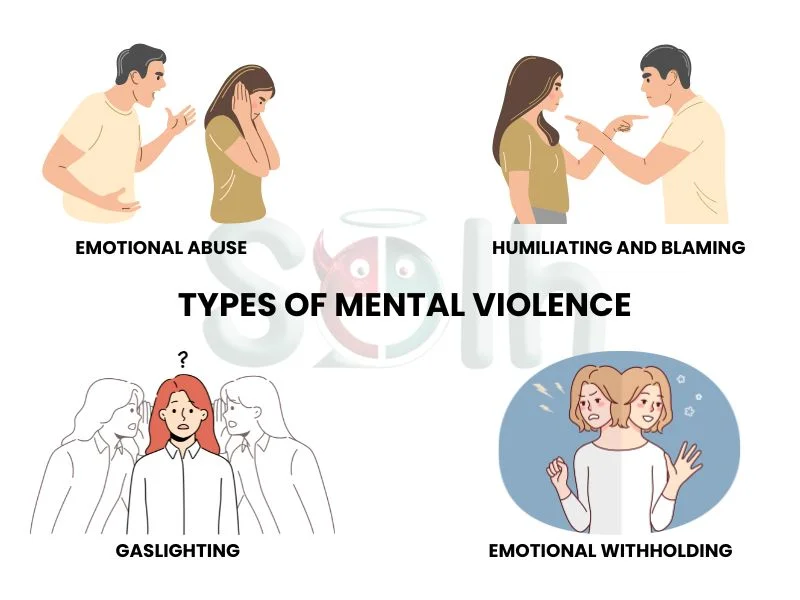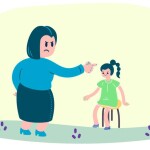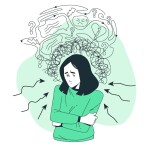Violence against women goes beyond physical harm; it usually takes an insidious form known as mental Violence, which is equally damaging but less visible. Mental Violence includes behaviors like emotional abuse, manipulation, coercion, and psychological control, leaving deep, often unseen scars on a woman's mental health and self-esteem.
This form of Violence is largely rife in personal relationships, workplaces, and even societal structures due to a lack of physical evidence, but it is easily overlooked or marginalized. Mental Violence stands to be not just an attack on a woman's dignity and autonomy but also an infringement on her basic human rights.
Understanding Mental Violence
Mental Violence can take many forms; survivors often question themselves and their perceptions and worth:
Emotional Abuse:
Constant belittling or humiliation with the purpose of demolishing a female's self-confidence.
Gaslighting: The abuser might distort facts and make the victim doubt the reality or his/her memory.
Manipulation and Coercion:
Guilt-tripping, isolation from friends and family, or threats to coerce.
Controlling everything the victim wears, whom he/she sees, and time spent on different things.
Psychological Control:
Creating a state of dependency or helplessness by eroding a woman's ability to make decisions for herself.
Fear tactics, including verbal threats or emotional blackmail, prevent her from seeking help or escaping.
Effects of Mental Violence :
The effects of mental Violence can be long-lasting and profound:
Mental Health Problems: Chronic anxiety, depression, PTSD, and low self-esteem are common outcomes. Survivors often feel trapped, believing there's no escape or support.
Physical Consequences: Psychological Violence can cause physical health conditions, for example, sleeplessness, headaches, digestive problems, and low resistance.
Economic Consequences: Victims become financially dependent on the abuser if he or she has the power to regulate their access to resources or undermines their professional capabilities.
Relationship Problems: Victims of psychological Violence may face difficulties in building trust or healthy relationships in the future.
Breaking Free from Psychological Violence
Healing from mental abuse starts with identifying and reaching out for help:
Introspection and Validation:
- Acknowledge abusive behavior and know that mental Violence is not your fault.
- Verify your feelings and experiences as factual and valuable.
- Seek Help: Ask for emotional aid from supportive friends, loved ones, or professional therapists.
- Meet fellow survivors who share and develop strengths.
Therapeutic Measures:
Therapy could help regain personal esteem, deal with trauma issues, and learn how to cope with stress. Mindfulness practices, such as journaling or meditation, promote emotional healing and clarity.
Empowerment through Education:
Know your rights and find resources for women suffering from psychological abuse.
Knowledge is power, and it can break the cycle of Violence.
Your Turn in Tacking Mental Violence
Violence in the mind thrives on silence and denial. All of us have a role in breaking up this cycle:
Start Conversations: Open the dialogue on mental Violence in schools, workplaces, and communities, which helps de-stigmatize survivors and creates awareness.
Challenge Harmful Norms: Challenge controlling or emotionally abusive behavior in personal
and public spheres.
Support Survivors: Share empathy and provide support for women experiencing mental Violence. Provide resources for them and create safe spaces to share their experiences.
Advocate for Change: Promote policies that treat and combat psychological abuse as part of wider violence prevention measures.
A World Free from Mental Violence
The silent epidemic of mental Violence against women is a very pressing matter. It demands urgency and needs a collective action that will increase awareness, give support, and challenge some aspects of societal norms.
Every small step—whether educating yourself, supporting a survivor, or advocating for systemic change—helps build a safer, more compassionate world where every woman can live with dignity and peace.
Your actions matter. Together, we can break the silence and ensure that no woman suffers in isolation.
There is so much to be shared, but first, tell me what you said:
Mental Violence: The Silent Epidemic Affecting Women's Well-Being
Violence against women is a complex issue, transcending only physical Violence to encompass mental Violence that may be as devastating as it often goes unnoticed. The impact of physical Violence is more obvious; it leaves marks . In contrast, mental Violence causes the gradual destruction of self-esteem, autonomy, and emotional strength, which may result in deeper, invisible wounds. It cuts across personal relationships, the workplace, and society in general but is underacknowledged and inadequately addressed.
Mental Violence is not just an individual problem; it is a societal one. Addressing it requires a collective commitment to recognize, challenge, and eliminate it at its roots. This blog aims to shed light on the forms, impacts, and pathways to overcoming mental Violence, providing actionable steps for individuals and communities to create a safer and more equitable world for women.
Understanding Mental Violence
Mental Violence refers to the whole series of acts to dominate, intimidate, or destabilize a woman's mind. It does not involve the kind of physical evidence of injuries; however, its consequences are equally destructive.
Types of Mental Violence :

Emotional Abuse: Emotional abuse refers to the use of verbal and non-verbal actions to belittle or demean a woman's sense of self:
Humiliating and Blaming: Prolonged enumeration of weaknesses or mistakes to chip away at confidence.
Gaslighting: A manipulative tactic where the abuser distorts reality, causing the victim to doubt their perceptions and memories.
Emotional Withholding: Refusing affection, attention, or validation as a means of control.
Manipulation and Coercion
These tactics aim to isolate or control a woman's choices:
- Guilt-Tripping: Inducing feelings of guilt to force compliance.
- Isolation: Cutting off access to friends, family, or social support networks.
- Threats: Using fear of consequences to suppress autonomy.
Psychological Control: Psychological control tries to deprive a woman of her autonomy and self-control.
- Surveillance: Following all her movements, conversations, or online activities excessively.
- Creating dependency: Financial, emotional, or logistical dependency so that she cannot leave.
- Verbal intimidation: Using hostile language or tone to intimidate her.
The Ruinous Effect of Mental Violence
Mental Violence touches every part of a woman's life, from her mental and emotional health to her physical health and economic independence.
1. Mental and Emotional Health
Chronic Stress and Anxiety: The pervasive dread and the pressure accompanying mental Violence typically trigger chronic levels of stress and anxiety disorder.
Depression: Many survivors become worthless, hopeless, and isolated.
PTSD: Such repeated victimization results in flashbacks, hypervigilance, and emotional numbness.
2. Physical Health Outcomes
The psychological impact of mental Violence appears to be physically
Sleep Disorders: It causes insomnia, nightmares, and sleeping disorders.
Psychosomatic Symptoms: Headaches, digestive problems, and chronic pain may be the result of chronic stress.
Weakened Immunity: In many cases, the immune system of a victim of mental abuse weakens.
3. Economic Consequences
Mental abuse usually restricts the economic capabilities of a woman to:
Workplace Harassment: Psychological abuse in the workplace can lead to decreased productivity, absenteeism, or even job loss.
Financial Control: Abusers usually cut off access to money or resources, creating a situation of financial dependence.
4. Social and Interpersonal Difficulties
Isolation: Survivors feel isolated from friends, family, and support networks.
Difficulty in Trusting Others: Abuse causes a barrier to forming healthy relationships in the future.
Breaking the Cycle of Mental Violence : Breaking free from mental Violence is difficult but not impossible with awareness, support, and action.
1. Identifying the Signs
The first step to breaking free is identifying mental Violence:
Do people frequently belittle, manipulate, or control you?
Do you feel trapped, powerless, or dependent in your relationships?
Have you doubted your memories or perceptions due to someone else's behavior?
Recognizing these signs can be difficult, as mental Violence often erodes confidence and clarity. Self-reflection and external validation from trusted friends or professionals can help.
2. Building a Support System
Breaking free from mental Violence requires a strong support network:
Friends and Family: Share your experiences with people you trust. Their encouragement can provide strength and perspective.
Support Groups: In a relationship of mutual support, sharing similar struggles breeds solidarity and healing.
Professional Support: Therapists and counselors assist in recovery while rebuilding the shattered self.
3. Therapy Interventions
In most cases, mental Violence heals through therapy.
Cognitive Behavioral Therapy: It makes a survivor think of breaking off the shackles of harmful thought processes and builds upon healthier coping strategies.
Mindfulness and Meditation: Practicing mindfulness can keep survivors connected with the moment, making the stress level decrease.
Art and Writing Therapy: Creative outlets allow survivors to process their emotions and reclaim their narratives.
4. Legal and Social Resources
There are so many organizations and legal frameworks in place to support and protect survivors.
Helplines: Confidential hotlines are available to provide immediate assistance and guidance.
Shelters: Safe havens offering temporary housing for women escaping abusive situations.
Legal Aid: Many jurisdictions have laws against psychological abuse, offering legal recourse for survivors.
A Call to Action: Ending Mental Violence
Dealing with mental Violence needs collective effort at individual, community, and societal levels.
1. Education and Awareness
Start Conversations: Have an open discussion about mental Violence to reduce stigma and motivate survivors to seek help.
Promote Healthy Relationships: Schools and communities need to educate people regarding respect, consent, and communication.
2. Advocacy and Policy Change
Strengthen Laws: Advocate policies that consider psychological abuse a crime.
Increase Funding: Press for more funds to support shelters, counseling, and legal aid.
3. Challenging Cultural Norms
Media Representation: Encourage media to portray women with dignity and challenge harmful stereotypes.
Solh understands. We offer a variety of features to help you invest in self-care and stress management.
Journaling for Self-Reflection: Sometimes, failure to care for oneself is the inability to understand oneself. Solh's journal feature provides you with space to express your thoughts and feelings. Reflecting on your experiences and desires is like discovering what stops you from self-care.
Anonymous Support Groups: You are not alone. Solh's anonymous support groups on Domestic Violence connect you to others who know exactly what the hassle is all about. Share your experiences, find comfort in solidarity, and discover new perspectives on overcoming the hurdle to indulge in self-care.
Solh Buddy: Ever feel lost in the woods or wholly disconnected? Your Solh Buddy is here for you- personalized, virtual support. It can give you prompts, celebrate your wins, and remind you of your strengths as you journey toward self-care.
Talk now: Sometimes dealing with Violence is overwhelming. Through Solh's Talk Now feature, access counselors who will walk you through those moments.
Solh believes in a unique way of introducing self-care. We empower you to take charge of your well-being by offering a variety of tools. Explore Solh today and discover the power of self-reflection, connection, and support in overcoming any problem of the mind. You're not alone on this path.
Balance Your Life with the Solh App
With the Solh App, wellness got easier. An innovative addition called Streffie, a stress monitor, helps you identify and measure perceived and actual stress levels. The app empowers you to take control of your mental well-being, prioritize self-care, and maintain a healthy work-life balance with actionable insights from Solh.
Download the Solh App and take the first step to a stress-free, balanced life!








